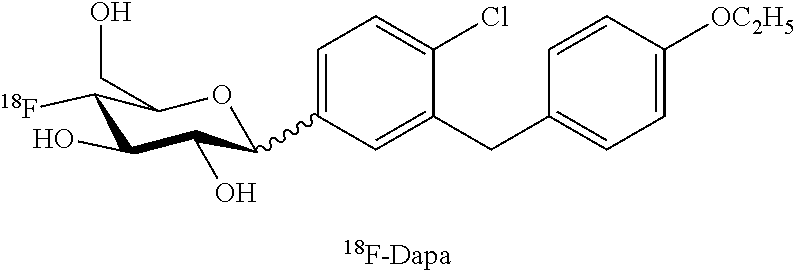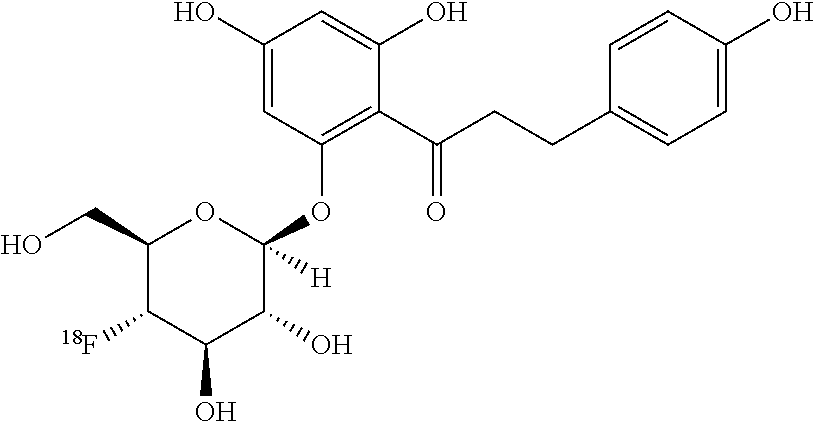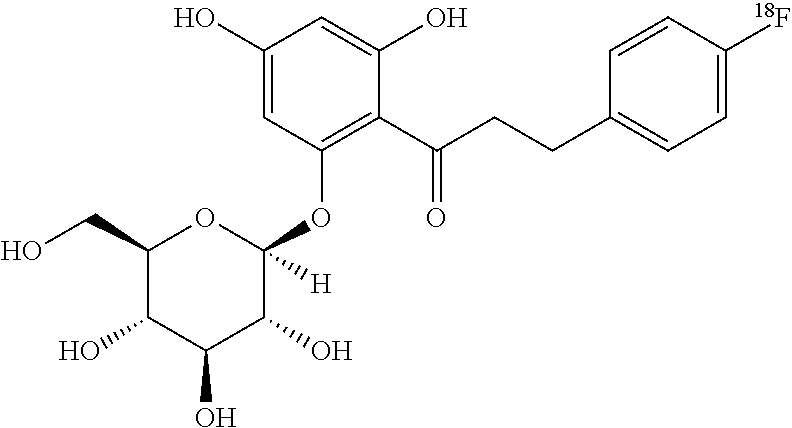Inhibitor probes for imaging sodium-glucose cotransporters in health and disease
a sodium-glucose cotransporter and inhibitor probe technology, applied in the field of radiolabeled tracers and methods for detecting sodium-glucose cotransporters, can solve the problems of poor substrates of mannose and 2-deoxy-d-glucose for sglts, glucose toxicity, blood vessels, etc., to reduce the rapid metabolism of inhibitors, reduce the rate of glucuronidation, and increase the life of parent drugs
- Summary
- Abstract
- Description
- Claims
- Application Information
AI Technical Summary
Benefits of technology
Problems solved by technology
Method used
Image
Examples
Embodiment Construction
[0035]The first aspect of the invention is the synthesis of [18F]fluoro, and [123I]iodo- SGLT inhibitors.
[0036]FIG. 3 provides a schematic description of radiolabeled tracers for SGLTs incorporating features of the invention. These radio labeled tracers comprise a sugar moiety (the 6 membered ring shown on the left of FIG. 3) connected by Z to ring A which is in turn connected to ring B by Y, one or more of the substitutions in the sugar moiety, ring A or ring B being a radiolabeled halogen. Ring A and B are the same or different phenyl, heterocyclic or fused aromatic rings.
[0037]Representative examples of radiolabeled SGLT inhibitors within the scope of FIG. 3 include, for example, the following compounds:
TABLE 34-[18F]-phlorizin (18F on C4 of D-glucose)[18F]-phlorizin (18F on B-ring of aglycone)4-[18F]-dapagliflozin (18F on C4 of D-glucose)3-[18F]-dapagliflozin (18F on C3 of D-glucose)4-[18F]-3-O—Me-dapagliflozin (18F on C4 of 3-O—Me-D-glucose)[18F]-3-O—Me-dapagliflozin (18F on A-...
PUM
| Property | Measurement | Unit |
|---|---|---|
| Electrical conductance | aaaaa | aaaaa |
| Current | aaaaa | aaaaa |
| Current | aaaaa | aaaaa |
Abstract
Description
Claims
Application Information
 Login to View More
Login to View More - R&D
- Intellectual Property
- Life Sciences
- Materials
- Tech Scout
- Unparalleled Data Quality
- Higher Quality Content
- 60% Fewer Hallucinations
Browse by: Latest US Patents, China's latest patents, Technical Efficacy Thesaurus, Application Domain, Technology Topic, Popular Technical Reports.
© 2025 PatSnap. All rights reserved.Legal|Privacy policy|Modern Slavery Act Transparency Statement|Sitemap|About US| Contact US: help@patsnap.com



